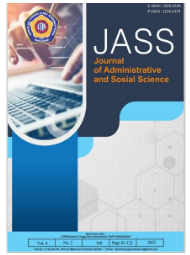Persimpangan Etika, Materialisme, dan Branding dalam Iklan Televisi Produk Konsumen
DOI:
https://doi.org/10.55606/jass.v6i2.1866Keywords:
Television Advertising, Advertising Ethics, Consumption Culture, Semiotic Analysis, Branding, Media LiteracyAbstract
This research discusses the role of television advertising as a medium for conveying cultural and ethical values in consumer society. Through a semiotic analysis approach, this study highlights how messages in advertising implicitly and explicitly encourage consumption patterns and construct a social reality that associates happiness and success with material possessions. In addition, branding strategies in advertising are proven to play an important role in shaping consumer identity through the emotional associations built between products and lifestyle. However, advertising practices often ignore ethical principles such as honesty, fairness and social responsibility, especially towards vulnerable groups. The results of this research emphasize the importance of integrating ethical values in the advertising creative process and increasing public media literacy in order to create a healthier and more sustainable communication environment.
References
[1] G. Belch dan M. Belch, Advertising and Promotion: An Integrated Marketing Communications Perspective, 11th ed., New York: McGraw-Hill, 2018.
[2] R. W. Pollay, “The distorted mirror: Reflections on the unintended consequences of advertising,” Journal of Marketing, vol. 50, no. 2, pp. 18–36, 1986.
[3] T. Drumwright dan P. Murphy, “How advertising practitioners view ethics,” Journal of Advertising, vol. 33, no. 2, pp. 7–20, 2004.
[4] D. Aaker, Building Strong Brands, New York: Free Press, 1996.
[5] J. Williamson, Decoding Advertisements: Ideology and Meaning in Advertising, London: Marion Boyars, 1978.
[6] D. McQuail, Mass Communication Theory, 6th ed., London: Sage Publications, 2010.
[7] A. C. Ferrell and O. C. Ferrell, Business Ethics: Ethical Decision Making and Cases, 12th ed., Cengage Learning, 2020.
[8] P. Kotler and K. L. Keller, Marketing Management, 15th ed., Pearson, 2016.
[9] L. Drumwright and P. Murphy, "How Advertising Practitioners View Ethics: Moral Muteness, Moral Myopia, and Moral Imagination," Journal of Advertising, vol. 33, no. 2, pp. 7-24, 2004.
[10] W. Wilkie and E. Moore, "What Does the FTC Mean by ‘Unfair’ Advertising?," Journal of Public Policy & Marketing, vol. 18, no. 2, pp. 123-131, 1999.
[11] Persatuan Perusahaan Periklanan Indonesia (P3I), Kode Etik Pariwara Indonesia, 2020.
[12] D. Buckingham, Children and Television: A Critical Overview of the Research, Polity Press, 2002.
[13] A. Abidin, "Communicative Intimacies: Influencers and Perceived Interconnectedness," Ada: A Journal of Gender, New Media, and Technology, no. 8, 2016.
[14] J. Kilbourne, Can't Buy My Love: How Advertising Changes the Way We Think and Feel, Simon and Schuster, 1999.
[15] Federal Trade Commission (FTC), "Guides Concerning the Use of Endorsements and Testimonials in Advertising", 2019.
[16] C. Becker-Olsen, B. Cudmore, and R. Hill, "The Impact of Perceived Corporate Social Responsibility on Consumer Behavior," Journal of Business Research, vol. 59, no. 1, pp. 46-53, 2006.
[17] C. M. Holson, “Pepsi Pulls Ad Accused of Trivializing Black Lives Matter,” The New York Times, Apr. 5, 2017.
[18] G. T. Papania and S. Murphy, "Advertising Ethics: Crisis of the Modern World," Journal of Business Ethics, vol. 14, no. 2, pp. 157-164, 1995.
[19] A. R. Pratama, “Pengaruh Iklan Terhadap Gaya Hidup Konsumen,” Jurnal Komunikasi, vol. 10, no. 2, pp. 112–119, 2020.
[20] G. Richins and S. Dawson, “A consumer values orientation for materialism and its measurement: Scale development and validation,” J. Consumer Res., vol. 19, no. 3, pp. 303–316, 1992.
[21] L. Chan and K. Prendergast, “Materialism and advertising: An analysis of young consumers in Hong Kong,” Young Consumers, vol. 8, no. 2, pp. 102–112, 2007.
[22] S. Belk, “Materialism and the modern consumer,” J. Consumer Behavior, vol. 6, no. 5, pp. 251–259, 2005.
[23] W. O’Cass and H. Frost, “Status brands: Examining the effects of non-product-related brand associations on status and conspicuous consumption,” J. Product Brand Manage., vol. 11, no. 2, pp. 67–88, 2002.
[24] J. Kasser, The High Price of Materialism. Cambridge, MA: MIT Press, 2002.
[25] T. Roberts and P. Clement, “Materialism and self-esteem: A closer look at the crossroads,” J. Social Psychology, vol. 148, no. 5, pp. 463–476, 2008.
[26] Z. Bauman, Consuming Life. Cambridge: Polity Press, 2007.
[27] N. Klein, No Logo: Taking Aim at the Brand Bullies. Toronto: Knopf Canada, 1999.
[28] Ofcom, “Children and Parents: Media Use and Attitudes Report 2020,” Ofcom, London, 2020. [Online]. Available: https://www.ofcom.org.uk/
[29] J. Buckingham, “The importance of media literacy in the age of consumerism,” Media Education Journal, vol. 24, no. 1, pp. 45–52, 2019.
[30] M. H. Firdaus, “Literasi Media dan Perilaku Konsumtif Generasi Milenial,” Jurnal Ilmu Komunikasi, vol. 15, no. 1, pp. 35–48, 2021.
[31] K. Keller, Strategic Brand Management: Building, Measuring, and Managing Brand Equity, 4th ed. Pearson, 2013.
[32] A. Kotler and P. Keller, Marketing Management, 15th ed. Pearson, 2016.
[33] S. Holt, D. Quelch, and E. Taylor, “How global brands compete,” Harvard Business Review, vol. 82, no. 9, pp. 68–75, 2004.
[34] J. G. Balmer, “Corporate brand management imperatives: custodianship, credibility, and calibration,” California Management Review, vol. 46, no. 3, pp. 70–87, 2004.
[35] T. Aaker, Aaker on Branding: 20 Principles that Drive Success. Morgan James Publishing, 2014.
[36] E. Wibowo and S. Wijaya, “Branding dan kampanye sosial di Indonesia: studi pada perusahaan retail,” Jurnal Komunikasi Indonesia, vol. 9, no. 1, pp. 1–12, 2022.
[37] L. Moorman, “Brand activism: Does taking a stand help or hurt brands?,” Journal of Marketing Research, vol. 57, no. 5, pp. 820–836, 2020.
[38] M. Porter and M. Kramer, “Creating shared value,” Harvard Business Review, vol. 89, no. 1/2, pp. 62–77, 2011.
[39] A. Vredenburg, K. Kapitan, S. Spry, and A. Kemper, “Brands taking a stand: Authentic brand activism or woke washing?,” Journal of Public Policy & Marketing, vol. 39, no. 4, pp. 444–460, 2020.
[40] J. Hootsuite, “Social Media Trends 2023,” [Online]. Available: https://www.hootsuite.com/resources/social-trends-2023.
Downloads
Published
How to Cite
Issue
Section
License
Copyright (c) 2025 JOURNAL OF ADMINISTRATIVE AND SOCIAL SCIENCE

This work is licensed under a Creative Commons Attribution-ShareAlike 4.0 International License.








